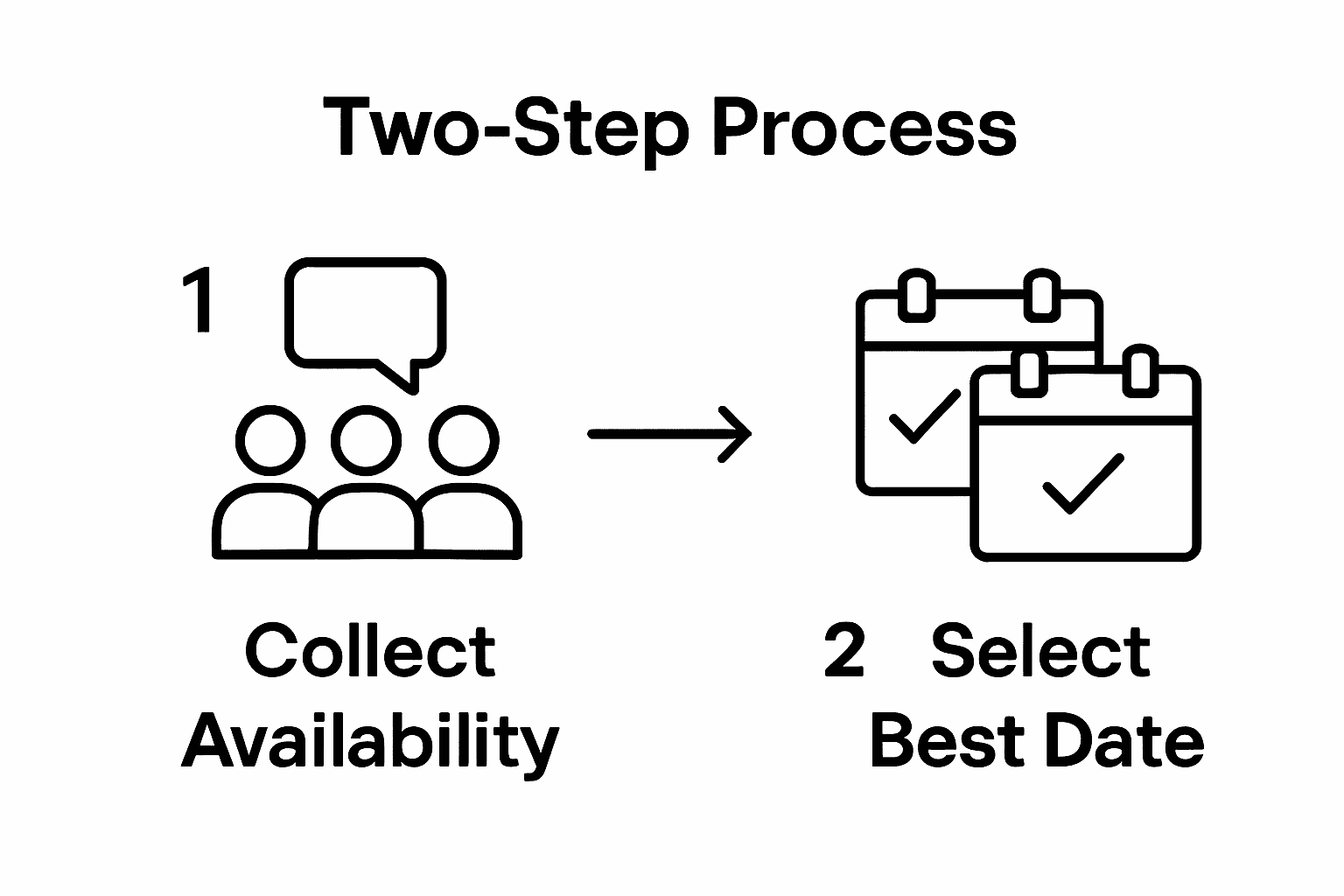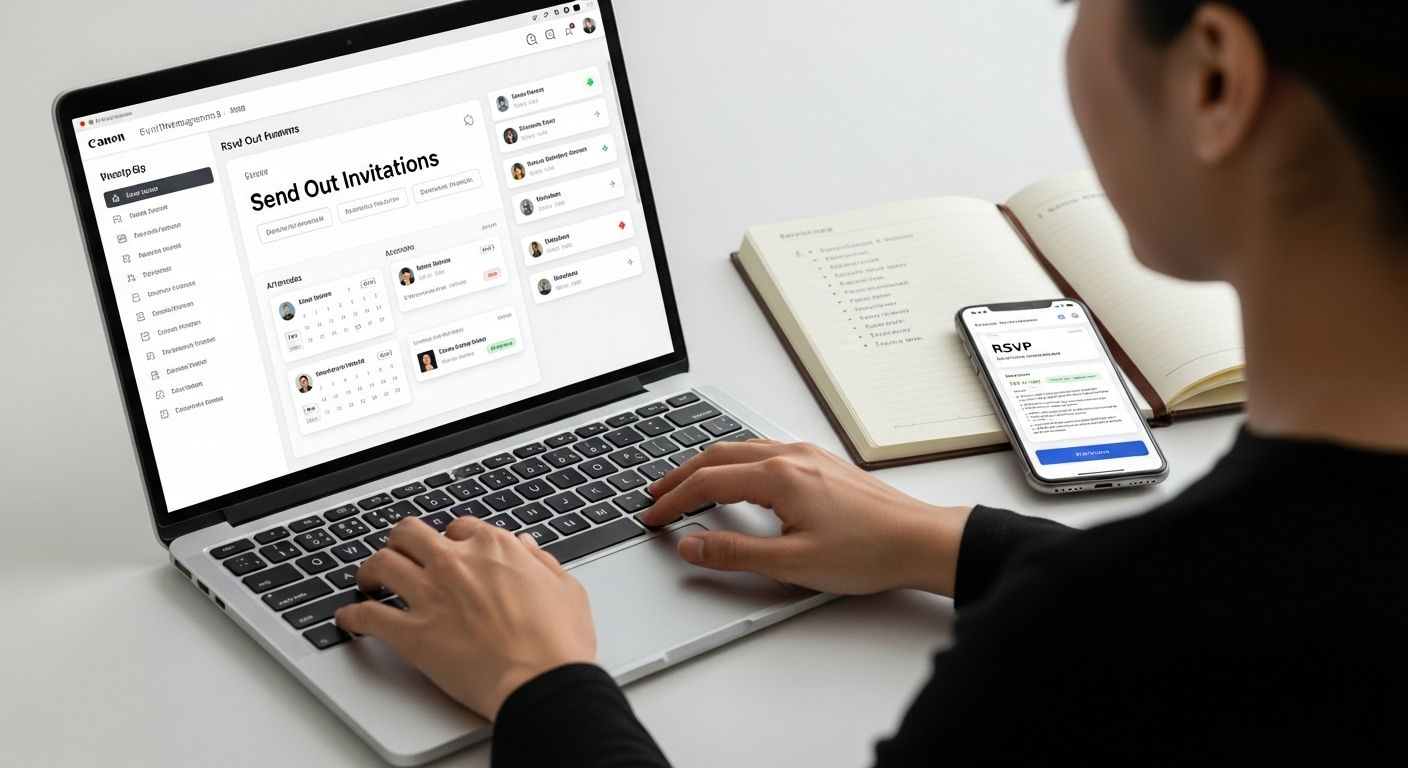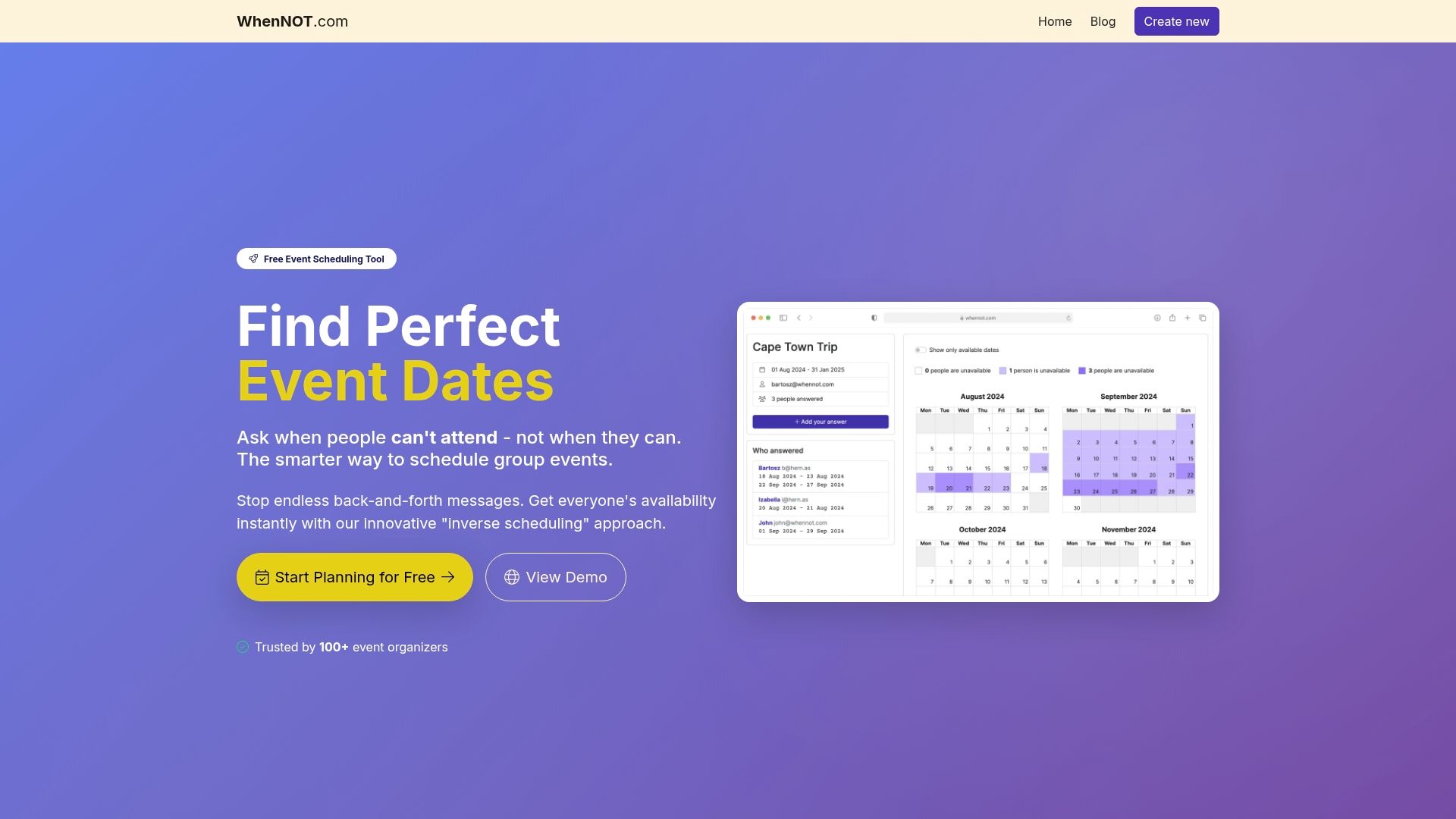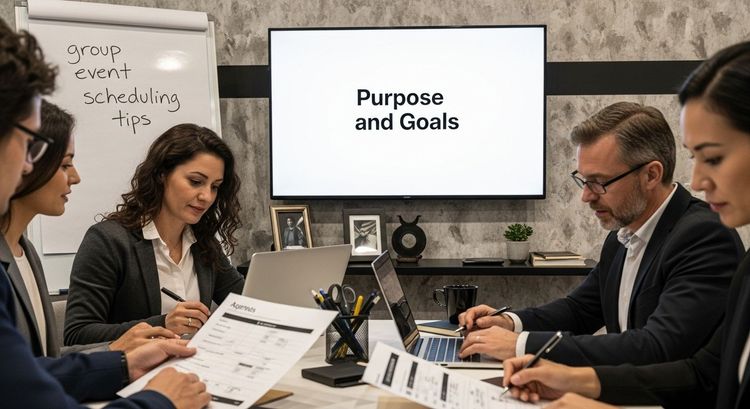Planning a group event sounds simple at first. Most people think it is just picking a date and sending out invites. But almost two-thirds of organizers admit that scheduling is the hardest part of pulling off a successful gathering. What really changes everything is how you approach those first decisions—because what matters most is not the date, but aligning everyone around a clear purpose right from the start.
Table of Contents
- Step 1: Identify The Purpose And Goals Of Your Event
- Step 2: Gather Availability From Participants
- Step 3: Choose A Suitable Date And Location
- Step 4: Send Out Invitations And Manage RSVPs
- Step 5: Finalize Details And Confirm Arrangements
- Step 6: Follow Up On Attendance And Feedback Post-Event
Quick Summary
| Key Point | Explanation |
|---|---|
| 1. Define Clear Event Objectives | Establish precise goals to guide planning, such as team building or knowledge sharing, ensuring focused logistics and engagement. |
| 2. Gather Participants' Availability Efficiently | Use user-friendly tools to collect availability; minimize complexity to ensure accurate participant scheduling. |
| 3. Choose Date and Location Thoughtfully | Select dates that accommodate the majority and venues that meet logistical needs and participant comfort for a successful event. |
| 4. Craft Personalized Invitations | Send clear invitations detailing event specifics; personalize them to enhance engagement and set expectations appropriately. |
| 5. Collect Feedback Post-Event | Use concise surveys to gather actionable insights and express gratitude, fostering ongoing participant relationships and event improvement. |
Step 1: Identify the Purpose and Goals of Your Event
Successful group event scheduling starts with crystal clear purpose definition. Before diving into logistics, you need a comprehensive understanding of why you are gathering and what you want to achieve. Whether organizing a corporate retreat, family reunion, or community workshop, the event's purpose will drive every subsequent planning decision.
Defining Your Event's Core Objectives
Begin by asking fundamental questions about your gathering. Are you aiming to build team connections, celebrate a milestone, share knowledge, or simply enjoy social time together? Each purpose demands a different approach to scheduling and coordination. A professional conference requires different planning strategies compared to a casual weekend getaway.
Carefully articulate specific, measurable goals that will guide your entire planning process. For instance, if you are organizing a team building event, your objectives might include increasing interdepartmental communication, boosting morale, or developing collaborative skills. By establishing these goals upfront, you create a framework that helps you select optimal dates, choose appropriate venues, and design engaging activities.
Stakeholder Alignment and Expectations
Once you have a preliminary vision, engage key stakeholders to validate and refine your event purpose. This might involve surveying potential participants, consulting team leaders, or discussing expectations with family members. Getting input early prevents misalignments and ensures everyone feels invested in the event's success.
According to Harvard Business Review research on effective event planning, successful events have clearly communicated purposes that resonate with all participants. This alignment increases engagement, participation rates, and overall satisfaction.
Remember that your event's purpose will directly influence scheduling complexity. A multi day workshop requires more intricate coordination than a two hour meeting. By thoroughly understanding your objectives from the start, you set the stage for smoother group event scheduling and increase the likelihood of achieving your desired outcomes.
Step 2: Gather Availability from Participants
Collecting participant availability is a critical phase in group event scheduling that transforms your initial vision into a feasible plan. This step requires strategic communication and smart tools to synchronize multiple schedules effectively.
Communication and Data Collection Strategies
Start by reaching out to all potential participants with clear, concise communication about the event and your scheduling needs. Your message should outline the event's purpose, potential date ranges, and a straightforward method for sharing availability. Digital tools have revolutionized this process, making it easier than ever to coordinate complex schedules across different time zones and work environments.
Practical Approaches to Availability Tracking
Choosing the right method for gathering availability can significantly impact your planning efficiency. Traditional email chains and spreadsheets often lead to confusion and endless back-and-forth communication. Modern group event scheduling approaches prioritize simplicity and user-friendly interfaces that minimize participant effort.
According to MIT Sloan Management Review research on collaborative scheduling, successful groups use tools that reduce cognitive load and make sharing availability intuitive. This means selecting platforms that allow participants to quickly indicate their unavailable times without complex registration processes.
Consider using specialized scheduling tools that generate unique links participants can access without creating accounts. These platforms allow individuals to mark their unavailable dates quickly, creating a visual representation of collective availability. By minimizing friction in the data collection process, you increase the likelihood of getting comprehensive and accurate schedule information.
When collecting availability, be mindful of potential scheduling challenges. Some participants might have recurring commitments, travel plans, or time zone differences that complicate coordination. Provide clear instructions and offer multiple ways for participants to communicate their constraints. A flexible approach demonstrates respect for individual schedules and increases overall participant engagement.
Use this comparison table to identify the pros and cons of different methods for collecting participant availability as described in the article.
| Method | Pros | Cons |
|---|---|---|
| Email Chains | Familiar to most users; requires no extra tools. | Can become confusing with multiple replies; difficult to track overall availability. |
| Spreadsheets | Allows centralized data entry and tracking. | Prone to errors; can be cumbersome for many participants. |
| Dedicated Scheduling Tools | Intuitive interfaces; streamlined process; visualizes group availability. | May require initial setup or tool selection; occasional learning curve for new users. |
| Account-Free Scheduling Platforms | Fast and simple for participants; avoids registration hurdles. | Limited features in some free versions; may not support complex event needs. |

Successful availability gathering culminates in a clear, comprehensive view of potential event dates that work for the majority of your group. Look for overlapping windows of availability and be prepared to make reasonable compromises to accommodate diverse schedules.
Step 3: Choose a Suitable Date and Location
Selecting the perfect date and location represents a pivotal moment in group event scheduling. This critical step transforms your preliminary planning into a concrete blueprint, balancing participant availability with practical logistics and event objectives.
Strategic Date Selection
After gathering participant availability data, identify the date range that accommodates the maximum number of attendees. Look for time windows where conflicts are minimal and most participants can comfortably participate. Consider seasonal factors, work schedules, and potential holiday interruptions that might impact attendance. Flexibility is key in this process, as finding a universally perfect date is often impossible.
Prioritize dates that align with your event's purpose and participant constraints. For professional gatherings, avoid scheduling during peak business periods or major industry conferences. For social events, consider weekends or evenings when most people have more flexible schedules. If your group spans multiple time zones or includes international participants, be especially mindful of potential scheduling challenges.
Location and Logistics Considerations
The location you choose must balance practical requirements with participant comfort and event goals. Consider accessibility, transportation options, parking availability, and proximity to most participants. For virtual events, select a digital platform that supports your specific interaction needs, ensuring robust connectivity and user friendly features.
According to Stanford University's event planning guidelines, successful venue selection involves thorough assessment of space requirements, technological capabilities, and potential backup options. Physical locations should offer appropriate amenities, sufficient space, and a suitable atmosphere for your event type.
When evaluating potential venues, create a comprehensive checklist that includes critical factors like capacity, technical equipment, accessibility for all participants, and potential cost implications. For hybrid or virtual events, test digital platforms in advance to confirm smooth functionality and user experience.
Verify your date and location selections by confirming participant agreement, venue availability, and alignment with your original event objectives. A well chosen date and location sets the foundation for a successful gathering, demonstrating thoughtful planning and consideration of all participants' needs.
Step 4: Send Out Invitations and Manage RSVPs
Sending invitations and tracking responses represents a crucial phase in group event scheduling that transforms your planning from conceptual to actionable. This step requires clear communication, strategic outreach, and a systematic approach to managing participant confirmations.
Crafting Effective Invitations
Your invitation serves as the first comprehensive touchpoint for participants, setting expectations and providing critical event details. Design a clear, concise message that includes essential information such as event purpose, date, time, location, and any specific requirements or instructions. Personalization matters - tailor your invitation to reflect the event's tone and significance, whether it is a professional conference or a casual gathering.
Consider the communication channel that will most effectively reach your participants. While email remains a standard method, digital platforms and specialized event management tools can streamline the invitation and RSVP process. Choose a method that ensures high visibility and makes responding convenient for participants.
RSVP Tracking and Follow-up Strategies
Implement a structured system for tracking responses that allows you to monitor confirmations, potential attendance, and any outstanding invitees. Digital tools can automate much of this process, providing real time updates and reducing manual tracking efforts. Set clear RSVP deadlines that give participants sufficient time to respond while providing you adequate planning flexibility.
According to Eventbrite's event management research, successful event organizers follow up strategically with participants who have not responded. Send gentle reminder communications that are professional and understanding, recognizing that participants may have competing priorities.
Develop a contingency plan for managing unexpected changes in attendance. Some participants may need to cancel or modify their participation, so build flexibility into your event planning. Keep a waitlist or alternative participant pool if appropriate, and maintain open communication channels that allow for last minute adjustments.
Verify the success of your invitation and RSVP process by achieving a high response rate and maintaining a clear, up-to-date participant list. A well-managed invitation strategy ensures accurate headcount, reduces planning uncertainty, and sets a positive tone for your upcoming event.

Step 5: Finalize Details and Confirm Arrangements
The final stage of group event scheduling requires meticulous attention to detail and proactive coordination. This critical phase transforms your planning into a concrete, executable event strategy, ensuring every logistical element is carefully addressed and confirmed.
Comprehensive Logistical Coordination
Begin by creating a comprehensive checklist that encompasses all event requirements. This should include venue confirmations, catering arrangements, technical equipment needs, transportation considerations, and any special accommodations for participants. Detailed documentation is crucial in preventing last minute surprises and ensuring smooth execution.
Reach out to all key vendors, venues, and service providers to confirm specific arrangements. Verify precise timing, setup requirements, and any additional resources needed for your event. For virtual or hybrid events, conduct thorough technical rehearsals to test connectivity, audio visual equipment, and digital platform functionality. Confirm backup plans for potential technical challenges or unexpected disruptions.
Communication and Participant Preparation
Develop a clear communication plan that provides participants with comprehensive event information. This should include detailed logistics such as exact location, arrival instructions, required materials, dress code, and any preparatory steps participants need to take. Create a centralized information resource that participants can easily reference, reducing confusion and potential last minute questions.
According to Project Management Institute guidelines, successful event finalization involves creating a robust communication strategy that keeps all stakeholders informed and aligned. This means sending final confirmations, detailed agendas, and any necessary preparation materials well in advance of the event date.
Consider potential contingencies that might impact your event. Develop flexible backup plans for scenarios like unexpected participant cancellations, venue changes, or technical issues. Having adaptable strategies demonstrates professional planning and helps maintain event momentum even when challenges arise.
Verify your event readiness by conducting a final comprehensive review. Confirm that all arrangements are in place, participants are informed, and you have strategies for managing potential unexpected scenarios. A well-executed finalization process sets the stage for a successful and memorable group event.
Here is a checklist to help you confirm that all essential event logistics and participant communications are in place before the event day.
| Finalization Task | Description | Verification Step |
|---|---|---|
| Venue Confirmation | Ensure venue is booked, accessible, and provides required amenities. | Confirm booking and receive written agreement from venue. |
| Catering Arrangements | Double-check food, beverage, and special dietary accommodations as needed. | Reconfirm menu and delivery details with caterer. |
| Technical Equipment | Coordinate all required audio-visual or virtual meeting tools. | Test equipment and backup setups in advance. |
| Transportation | Arrange transportation or provide clear parking/transit instructions. | Verify booking or create directions for all attendees. |
| Participant Communication | Send out comprehensive event details and preparation instructions. | Confirm participants received and understood final communications. |
| Contingency Plans | Develop plans for unexpected changes or emergencies. | Communicate backup plans and assign responsibilities as needed. |
Step 6: Follow Up on Attendance and Feedback Post-Event
The post-event follow-up phase represents a critical opportunity to transform your group event from a singular experience into a valuable learning and relationship-building opportunity. This final step ensures participant satisfaction, captures meaningful insights, and sets the groundwork for future successful gatherings.
Strategic Communication and Appreciation
Immediately after the event, prioritize sending personalized thank you messages to all participants. Timing and sincerity are essential in these communications. Acknowledge individual contributions, highlight key moments from the event, and express genuine appreciation for their time and engagement. For professional events, this might include recognizing specific contributions or collaborative achievements. For social gatherings, focus on the shared experiences and connections formed.
Your follow-up communication should feel warm, genuine, and reflective of the event's overall tone. Include a brief summary of the event's key outcomes or memorable moments to reinforce the positive experience and maintain participant engagement.
Comprehensive Feedback Collection
Design a thoughtful, concise feedback mechanism that encourages honest and constructive responses. The goal is to gather actionable insights that can improve future event planning. Create a survey that balances quantitative rating questions with open-ended opportunities for detailed feedback. Keep the survey relatively short to maximize completion rates, focusing on critical aspects of the event experience.
According to Harvard Business Review's event management research, effective post-event surveys should explore participant satisfaction across multiple dimensions. This includes assessing the event's organizational quality, content relevance, networking opportunities, and overall value proposition.
Consider multiple feedback collection methods to accommodate different participant preferences. While online surveys are convenient, also be open to direct conversations, email responses, or even brief phone interviews for more in-depth insights. Pay special attention to both positive feedback and constructive criticism, viewing each response as an opportunity for continuous improvement.
Verify the success of your follow-up process by achieving a high survey response rate, maintaining positive communication with participants, and developing clear action items for future event enhancements. A thoughtful post-event approach demonstrates professionalism and commitment to participant experience.
Tired of Group Scheduling Nightmares? Discover a Solution That Solves Your Biggest Event Planning Challenges
If you have ever struggled to gather everyone's availability, juggled endless emails, or spent hours narrowing down dates, you are not alone. The pain of chasing down RSVPs, navigating conflicting schedules, and managing complex logistics can drain the excitement from even the most promising group event. This article unpacked the importance of clear objectives, seamless communication, and effortless coordination. Now, imagine using a tool built to eliminate back-and-forth and make scheduling truly stress-free.

Experience how WhenNOT makes it easy for your group to mark just the days they are busy. Our streamlined group event scheduling tool works without the hassle of account creation or complicated invites. See how visualizing everyone's unavailable dates in one place can save you hours of headache and help you finalize details faster. Stop wasting time and start planning smarter events today. Visit https://whennot.com and turn your next event into a smooth success.
Frequently Asked Questions
How do I identify the purpose of my group event?
To identify the purpose of your group event, ask fundamental questions about the gathering's goals. Consider whether you want to build relationships, celebrate milestones, share knowledge, or simply enjoy socializing. Defining specific, measurable objectives will guide your planning decisions.
What is the best way to gather participant availability for scheduling?
To gather participant availability effectively, communicate clearly about the event and your scheduling needs. Use user-friendly scheduling tools that allow participants to indicate their unavailable times easily without complex registration processes to minimize confusion.
How can I choose the best date and location for my event?
Select dates that accommodate the maximum number of participants by looking for overlapping availability. When choosing a location, consider access, transportation options, and whether the venue aligns with your event's purpose. Flexibility is crucial during this process.
What should I include in my invitations to ensure high RSVP rates?
Craft clear and concise invitations that include essential details like the event's purpose, date, location, and any specific instructions. Personalize the message to fit the event's tone, and choose effective communication channels for distribution to encourage participation.
